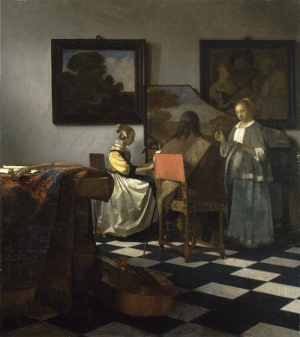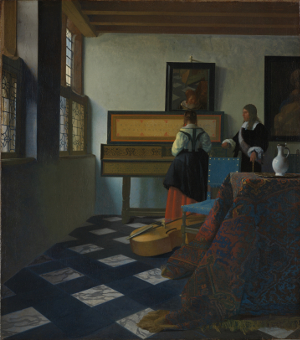A painting is a world without change and without sound. Vermeer's paintings, instead, are full of musical instruments and people making music. Music is present in almost one-third of his paintings, in one way or another. The fact that Vermeer portrayed so many musical themes is not surprising in itself, "at least ten percent of all seventeenth-century paintings, music makes its appearance in one way or another. In genre pieces, in which category Vermeer's work is generally placed, the percentage is even higher. For example, about twenty percent of Frans van Mieris' works, twenty-five percent of Pieter de Hooch's and almost fifty percent of Jacob Ochtervelt's deal in some way with music." Edwin Buijsen, "Music in the Age of Vermeer," in Dutch Society in the Age of Vermeer, (Zwolle: Waanders, 1996), 106.
The ability of painting to convey music and sound was not limited to the subjects they represented. Line, shape, and color, too, were central to a composition’s sense of harmony. When, in 1604, the Dutch theorist Karel van Mander (1548–1606) published his Het Schilder-boek (The Book of Painting ),Het Schilder-Boeck, written by Flemish writer and painter Karel van Mander, was first published in 1604 in Haarlem, in the Dutch Republic. This seminal work, written in 17th-century Dutch, is often translated as "The Book of Painters," "The Book of Painting," or "The Book on Picturing."It is composed of six parts and is a key source for the history of art and art theory in the 15th- and 16th-century Low Countries. The book achieved considerable success and was well-received upon publication. Van Mander passed away two years after its release. A second edition, including a brief, anonymous biography of Van Mander, was published posthumously in 1618. a manual for artists, he likened musical composition to the need for balance in a painted work: "Just as in music the multifarious sounds of the singers and the players harmonize, so here too (in painting) do the many different figures." Harmony, his dictum suggests, is found in the mechanics—or color and shape—of the composition, not just in the image itself.
Dutch painting experts generally believe that underneath Vermeer's seemingly straightforward portrayals of young people engaged in a pleasurable pastime lies another level of meaning which can be understood only with consultation of period emblematic literature and other historical references. To fully appreciate the significance of music in Vermeer's paintings, it is important to understand not only the related iconographical meaning, which is fascinating and informative, but alsot the musical milieu in Vermeer's time, the musical instruments in his compositions, their history and playing technique, and, lastly, the specific sounds of each instrument and the music performed on them. The following multi-media project investigates many of these issues.

Johannes Vermeer

Johannes Vermeer
Dutch Music and Songbooks

from: Marjorie E. Weisman, Vermeer and Music The Art of Love and LeisureMarjorie E. Weisman, Vermeer and Music: The Art of Love and Leisure, (London: National Gallery, 2013).
Whether sacred or secular, Dutch music of the seventeenth century was dominated by songs: simple, catchy and enormously popular. How were the songs disseminated? Oral tradition was strong, and it was also common practice for friends to exchange printed or manuscript music, even internationally, which the recipient would then copy and return. During the course of the seventeenth century, Amsterdam became a centre for music publishing, producing printed music to suit nearly every purse: from inexpensive song sheets hawked on street corners to deluxe music- and songbooks purveyed by publishers and specialist booksellers.
It is important to distinguish between two common types of musical publication: music books (printed scores, or tablature) and songbooks. Both were aimed primarily at amateurs with relatively little musical training, as full-time musicians were not only notoriously impecunious, but of necessity skilled mimics, adept at improvising and devising harmonies on the spot. Many music books contained ensemble music with melodic, bass, and harmony parts that could—depending on the instruments and players available—be performed using various combinations of instruments. Simplified adaptations of dance tunes were particularly popular, for accompanying dances among small circles of friends and family.
Unique among European countries, the Dutch eagerly embraced the printed songbook and developed it into a fine art. Described as 'a portable pharmacy for the soul', songbooks offered a selection of tunes designed to encourage love or soothe its pangs, dispel melancholy, or bring inner peace. The most deluxe publications featured varied typography and attractive layouts interspersed with engraved illustrations by well-known artists. Expensive volumes costing one or two guilders were often reissued in cheaper editions, costing just a few pennies, for a wider audience. The majority of songbooks contained text but no musical notation, just a brief indication of the tune to which they should be sung, typically traditional folk melodies or tunes imported from other countries. Verses could be sung to different tunes, and a single tune could host any number of lyrics. There was lively competition among publishers to include the newest verses, which ranged from poems by some of the most famous writers of the day, to amusingly vulgar rhymes and verses with strong local appeal that referenced area attractions or popular pastimes. These were the pop songs of the day: songs about love, drinking, sex, comic and satirical stories and, on occasion, even religious themes. Songs for a single voice were the most prevalent, sometimes accompanied by virginal, lute, cittern or other instruments.
Predictably, the most popular songs dealt with love in all its guises, and the most charming songbooks were those marketed to young adults enraptured by love's capricious triumphs and travails. Love songs provided entertainment and opportunity for romantic interaction, but also offered consolation in the event of disappointment. Illustrated songbooks were popular gifts from a young man to his sweetheart; most were quite small—about twelve by eighteen centimetres, or even smaller—and could be easily carried in a pocket or hidden from disapproving elders. Publishers quickly realised the commercial potential in the songbook's appeal as an intimate, erotic and eminently portable love-token. Some included a sentimental dedication page, with a space left blank for the suitor to personalise it with his beloved's name.
 Den nieuwen oerbeterden Lust-Hof (The New Improved Pleasure- Garden)
Den nieuwen oerbeterden Lust-Hof (The New Improved Pleasure- Garden)1607 (title page)
Michiel Vlacq
Engravings by Daniel Vingboom